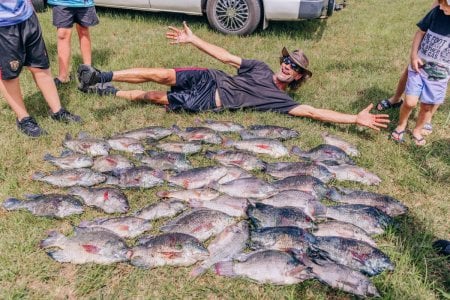Discover the shocking and sinister reality of Australia's massive 678kg fishing nightmare – What's lurking in your river?
- Replies 7
Australia is renowned for its rich biodiversity and unique ecosystems, but not all the creatures swimming in its waters are welcome. The recent haul of 678kg of fish from a river on the Gold Coast reveals a darker side to fishing in Australia, one that poses a significant threat to the country's aquatic environments.
The Gold Coast Pest Fish Classic, an event that began in 2016 and is run jointly between the council and My Catch Australia, has seen anglers pull out an astonishing 4,682 kilograms of pest fish from local waterways. This year's catch included a mix of Tilapia, European Carp, and goldfish – species that are wreaking havoc on Australia's rivers and lakes.
Tilapia, introduced to Australia in the 1970s, are now officially considered an invasive species. Native to regions including Africa and South America, these fish have become a major problem due to their competitive nature and unique reproductive habits. Female Tilapia carry their eggs and fry in their mouths, allowing young fish to survive even after the adult's death. This resilience makes them particularly difficult to eradicate.

European Carp, another invasive species, along with Tilapia, contribute to increased water turbidity, making the water cloudier and murkier. This not only affects the visibility for native species but can also lead to the erosion of riverbanks. Jack Gough, acting CEO of the Invasive Species Council, has highlighted the severity of the issue, stating that these invasive fish are competing with native species and pose a huge risk of spreading further into New South Wales.
The City of Gold Coast's mayor, Tom Tate, has commended the efforts of the anglers who participated in the Pest Fish Classic. Their efforts not only help to remove these destructive species but also raise awareness about the damage they can cause. In a positive turn, the fish caught in this year's event were not sent to landfill but instead will be composted, reducing carbon dioxide emissions and eventually enriching the soil.
In an attempt to bolster native fish populations, the council plans to release 36,000 Australian bass fingerlings into Robina Lakes. This initiative is part of a broader commitment to improve fish stocks that have been impacted by the presence of pest species.
The fight against invasive fish species in Australia is ongoing and complex. The government is exploring various methods to control the European Carp population, including the potential release of a herpes virus into river systems as part of the National Carp Plan. While this approach is not a complete solution, it could significantly aid in controlling their numbers.
However, there are concerns from local business owners, such as Tracy Hill from Coorong Wild Seafood, that the mass deaths of these 'feral fish' could lead to negative consequences for tourism and local industries. The fear is that decaying fish could turn waterways into 'a big, stinky rotten carp soup,' which would be detrimental to businesses reliant on clean and healthy aquatic environments.
The situation underscores the delicate balance required in managing Australia's ecosystems and the ongoing challenges posed by invasive species. It's a reminder that while fishing can be a delightful pastime, it also carries the responsibility of safeguarding the natural habitats we cherish.
 We at the Seniors Discount Club encourage our readers to stay informed about environmental issues and support local efforts to protect our precious waterways. Have you noticed the impact of invasive species in your local rivers or lakes? Share your experiences and thoughts in the comments below. Let's continue the conversation about preserving Australia's natural beauty for generations to come.
We at the Seniors Discount Club encourage our readers to stay informed about environmental issues and support local efforts to protect our precious waterways. Have you noticed the impact of invasive species in your local rivers or lakes? Share your experiences and thoughts in the comments below. Let's continue the conversation about preserving Australia's natural beauty for generations to come.
The Gold Coast Pest Fish Classic, an event that began in 2016 and is run jointly between the council and My Catch Australia, has seen anglers pull out an astonishing 4,682 kilograms of pest fish from local waterways. This year's catch included a mix of Tilapia, European Carp, and goldfish – species that are wreaking havoc on Australia's rivers and lakes.
Tilapia, introduced to Australia in the 1970s, are now officially considered an invasive species. Native to regions including Africa and South America, these fish have become a major problem due to their competitive nature and unique reproductive habits. Female Tilapia carry their eggs and fry in their mouths, allowing young fish to survive even after the adult's death. This resilience makes them particularly difficult to eradicate.

A total of 678.49kg of invasive species, including Tilapia, European Carp, and goldfish, were removed from the Robina waterways on the Gold Coast. Credit: Facebook / City of Gold Coast
European Carp, another invasive species, along with Tilapia, contribute to increased water turbidity, making the water cloudier and murkier. This not only affects the visibility for native species but can also lead to the erosion of riverbanks. Jack Gough, acting CEO of the Invasive Species Council, has highlighted the severity of the issue, stating that these invasive fish are competing with native species and pose a huge risk of spreading further into New South Wales.
The City of Gold Coast's mayor, Tom Tate, has commended the efforts of the anglers who participated in the Pest Fish Classic. Their efforts not only help to remove these destructive species but also raise awareness about the damage they can cause. In a positive turn, the fish caught in this year's event were not sent to landfill but instead will be composted, reducing carbon dioxide emissions and eventually enriching the soil.
In an attempt to bolster native fish populations, the council plans to release 36,000 Australian bass fingerlings into Robina Lakes. This initiative is part of a broader commitment to improve fish stocks that have been impacted by the presence of pest species.
The fight against invasive fish species in Australia is ongoing and complex. The government is exploring various methods to control the European Carp population, including the potential release of a herpes virus into river systems as part of the National Carp Plan. While this approach is not a complete solution, it could significantly aid in controlling their numbers.
However, there are concerns from local business owners, such as Tracy Hill from Coorong Wild Seafood, that the mass deaths of these 'feral fish' could lead to negative consequences for tourism and local industries. The fear is that decaying fish could turn waterways into 'a big, stinky rotten carp soup,' which would be detrimental to businesses reliant on clean and healthy aquatic environments.
The situation underscores the delicate balance required in managing Australia's ecosystems and the ongoing challenges posed by invasive species. It's a reminder that while fishing can be a delightful pastime, it also carries the responsibility of safeguarding the natural habitats we cherish.
Key Takeaways
- A substantial amount (678.49kg) of invasive species, such as Tilapia, European Carp, and goldfish, were caught and removed from the Robina waterways on the Gold Coast.
- These invasive species are causing significant environmental problems, competing with native fish for resources, and increasing water turbidity.
- The Gold Coast Pest Fish Classic has been effective in controlling the population of these pest fish, with over 4,682 kilograms removed since 2016.
- Measures are in place to prevent the spread of these species, and there are plans to improve native fish stocks and explore options such as introducing a herpes virus to control carp numbers.







